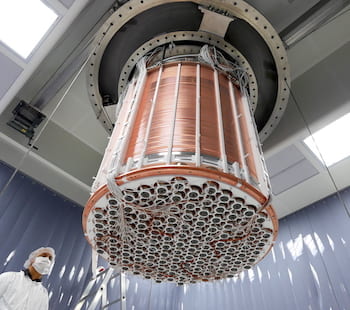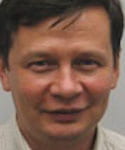Rice physicists at XENON1T experiment share announcement of possible axions
XENON1T has proven there’s no success like excess.
The experiment in Italy that includes Rice University scientists revealed today that it had detected excess — and perhaps cosmic — particles that probably aren’t evidence of the dark matter it has been seeking, but probably are evidence of another elusive class of particles, axions.
Christopher Tunnell, an assistant professor of physics and astronomy and of computer science, leads the Rice team of astroparticle physicists, including Petr Chaguine, an associate research professor. They are part of an international collaboration of 163 scientists from 28 institutions who co-authored a paper posted today to the preprint library arXiv. The paper has been submitted to a journal for peer review.

The XENON1T experiment in Italy, now shut down for upgrades, found excess signals that may be evidence of axions. Courtesy of the XENON Experiment
XENON1T is a highly sensitive dark matter experiment that operated deep underground in Italy through 2018 and is getting an upgrade, even during the COVID-19 pandemic.
Dark matter makes up an estimated 85% of the universe, but no direct evidence of its existence has been discovered. XENON1T was constructed to find it. The XENON1T detector contained 3.2 tons of ultrapure liquefied xenon, two tons of which served as a target for particle interactions.
When a particle crosses the target, it can generate tiny signals of light and free electrons from a xenon atom. Most of these interactions occur from particles that are known to exist. Scientists therefore carefully estimated the number of background events in XENON1T.
In the new paper, the collaborators revealed they observed a surprising excess of 53 events over the 232 they expected. “All discoveries in this field start out as an unexplained excess, where the excitement of seeing such an excess is counteracted by knowing the sheer amount of work required to understand it,” Tunnell said.
The source of the excess is not yet fully understood. The events’ signature is similar to what might result from a tiny residual amount of tritium (a hydrogen atom with one proton and two neutrons), but could also be a sign of something more exciting: Either a particle known as the solar axion, or the indication of previously unknown properties of neutrinos.
“It could be that while we were searching for dark matter, we found something even weirder,” Tunnell said.
So far, XENON1T scientists have only observed indirect evidence of dark matter, and a definitive, direct detection has yet to be made. So-called WIMPs (weakly interacting massive particles) are among the theoretically preferred candidates, and XENON1T has thus far performed the most sensitive search for these particles over a wide range of WIMP masses.
In addition to WIMP dark matter, XENON1T was also sensitive to different types of new particles and interactions that could explain other open questions in physics. Last year, using the same detector, the team published in Nature its observation of the rarest nuclear decay ever directly measured.
One explanation for the current excess could be a previously unconsidered source of background signal in the XENON1T detector caused by the presence of tiny amounts of tritium.
Tritium, a radioactive isotope of hydrogen, spontaneously decays by emitting an electron with an energy similar to what was observed. Only a few tritium atoms for every 10,000,000,000,000,000,000,000,000 xenon atoms would be needed to explain the excess. Currently, there is no way to confirm or disprove the presence of tritium at that level in the detector.
Another explanation could be the existence of a theoretical particle. In fact, the excess the researchers observed has an energy spectrum similar to that expected from axions produced in the sun.

Christopher Tunnell

Petr Chaguine
While these solar axions are not dark matter candidates, their detection would mark the first observation of a predicted but never-observed class of particles with a large impact not only on understanding of fundamental physics, but also on astrophysical phenomena. Moreover, axions produced in the early universe could also be the source of dark matter.
The excess could also be due to neutrinos, trillions of which pass through your body unhindered every second. One explanation could be that the magnetic moment (a property of all particles) of neutrinos is larger than its value in the Standard Model of elementary particles. The would require new physics to explain it, a challenge physicists generally welcome.
Of the three explanations considered by the XENON collaboration, the observed excess is statistically most consistent with a solar axion signal, though not enough to conclude that axions exist. Such a discovery claim would require explaining why stars do not evaporate by emitting so many axions.
With the experiment’s upgrade to XENONnT, which will have an active xenon mass three times larger and background signal that is expected to be lower than that of XENON1T, the collaborators are confident they’ll find out whether the excess is a mere statistical fluke, a background contaminant or something far more exciting: a new particle or interaction that goes beyond known physics.
“I remember hearing as a Ph.D. student the history of the solar neutrino problem, where an insufficient number of neutrinos were observed from the sun than expected,” Tunnell said. “Younger scientists thought that there must be new particle physics occurring, whereas older scientists always would pretend that there was some simple explanation, normally blaming astronomers.
“Even though as a scientist I am skeptical that we have observed new particle physics, I look forward to young scientists such as (Rice graduate student) Sophia Andaloro, who won a fellowship to study related signals, to demonstrate my folly.”

